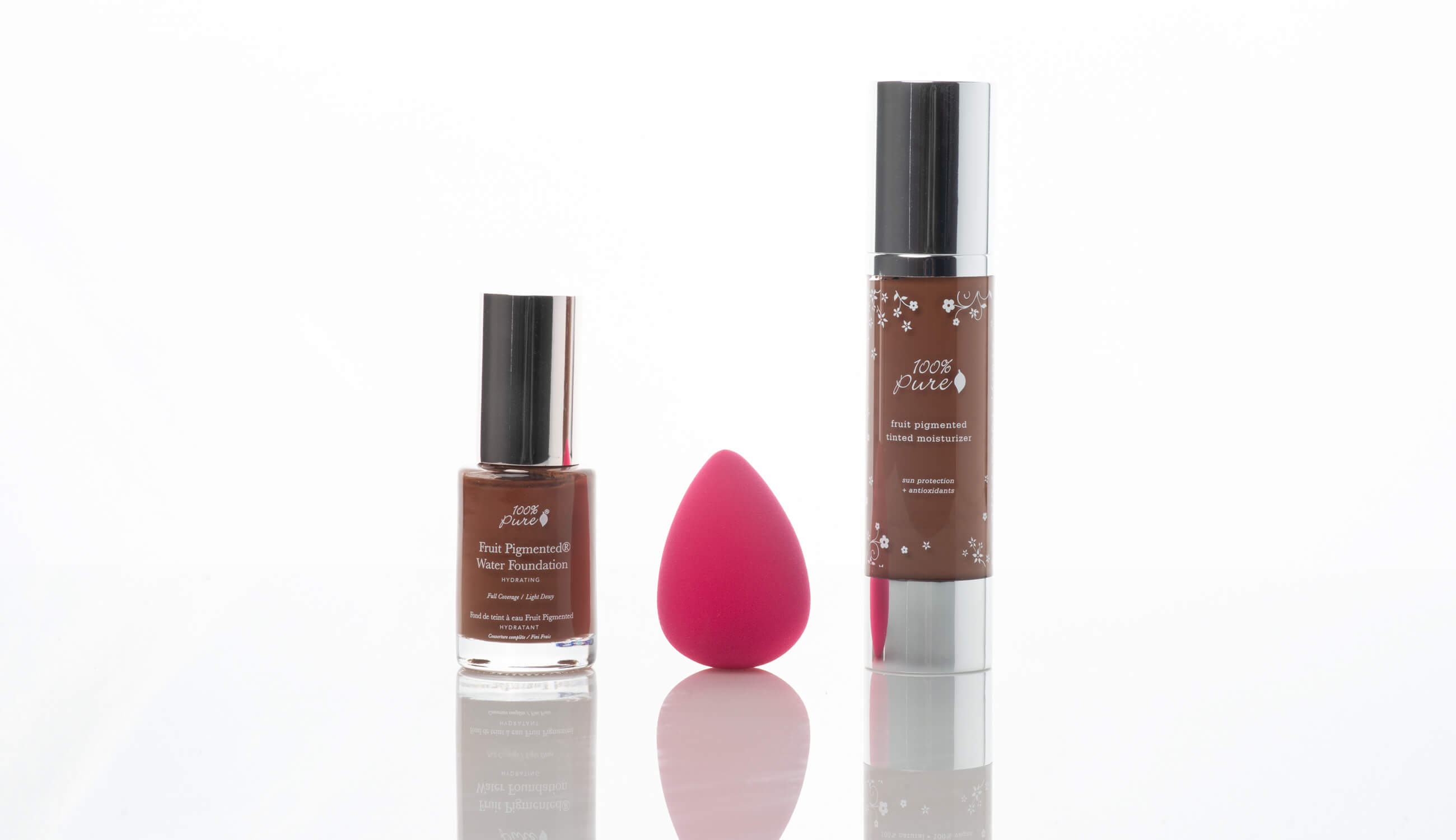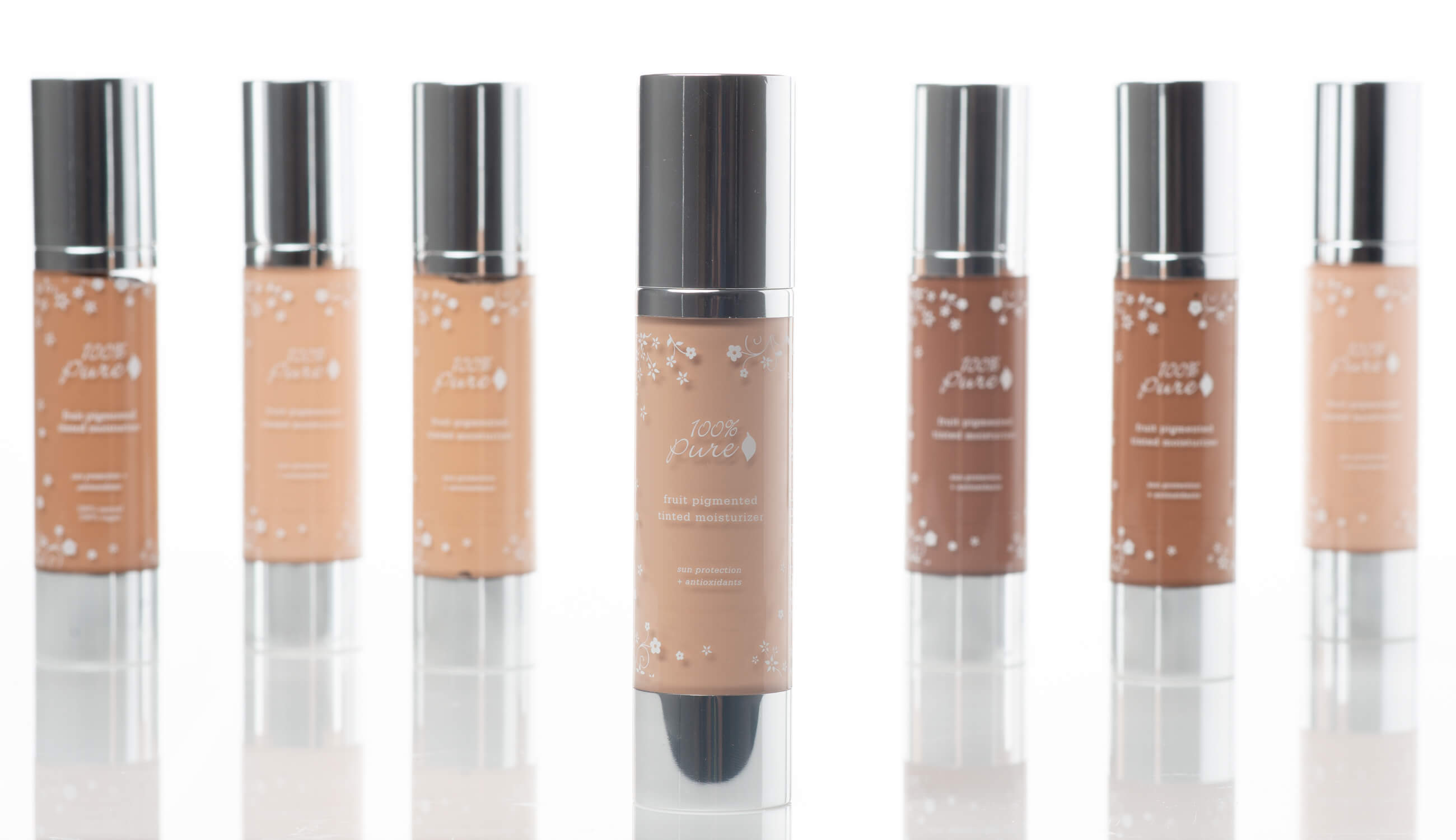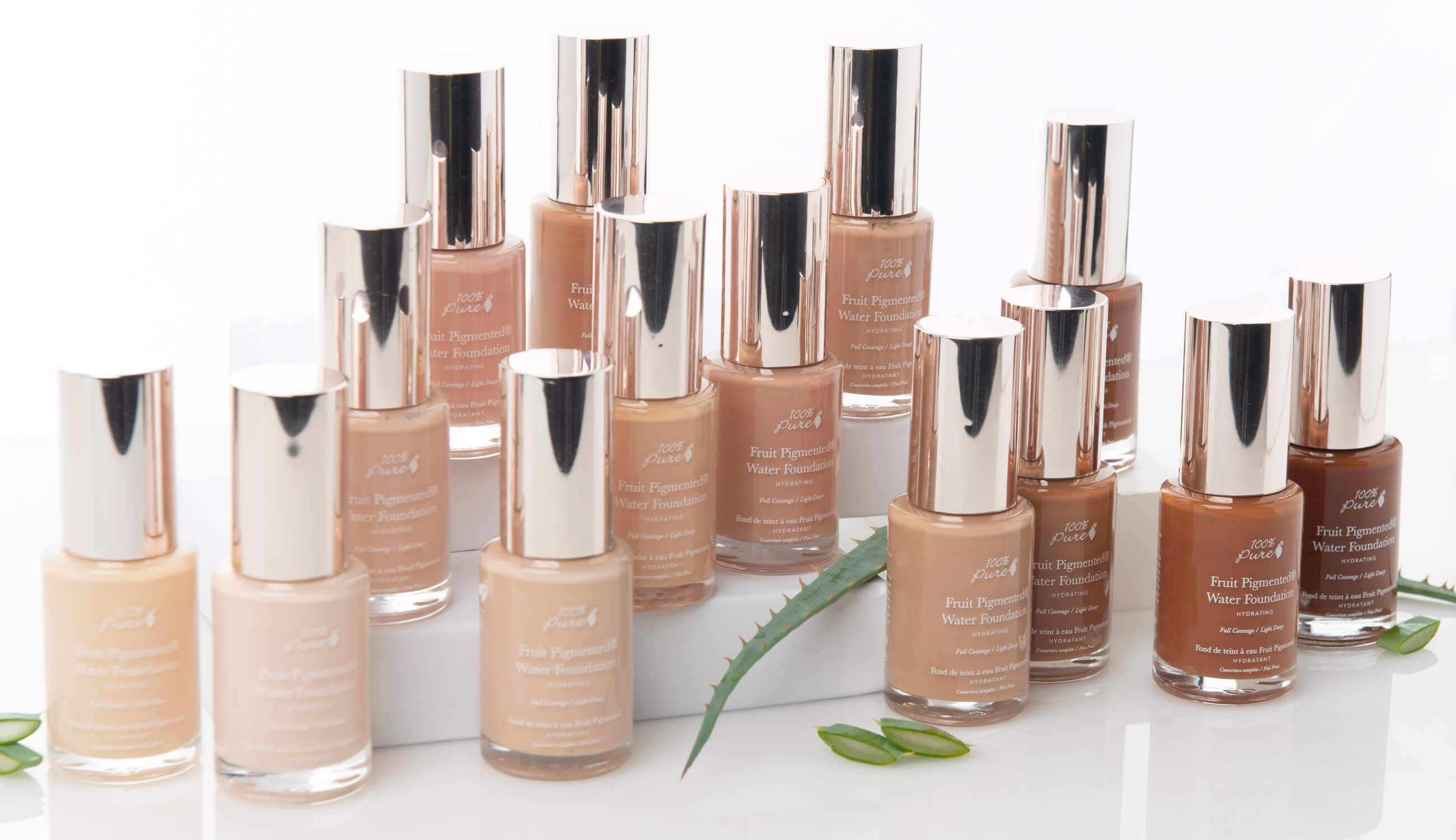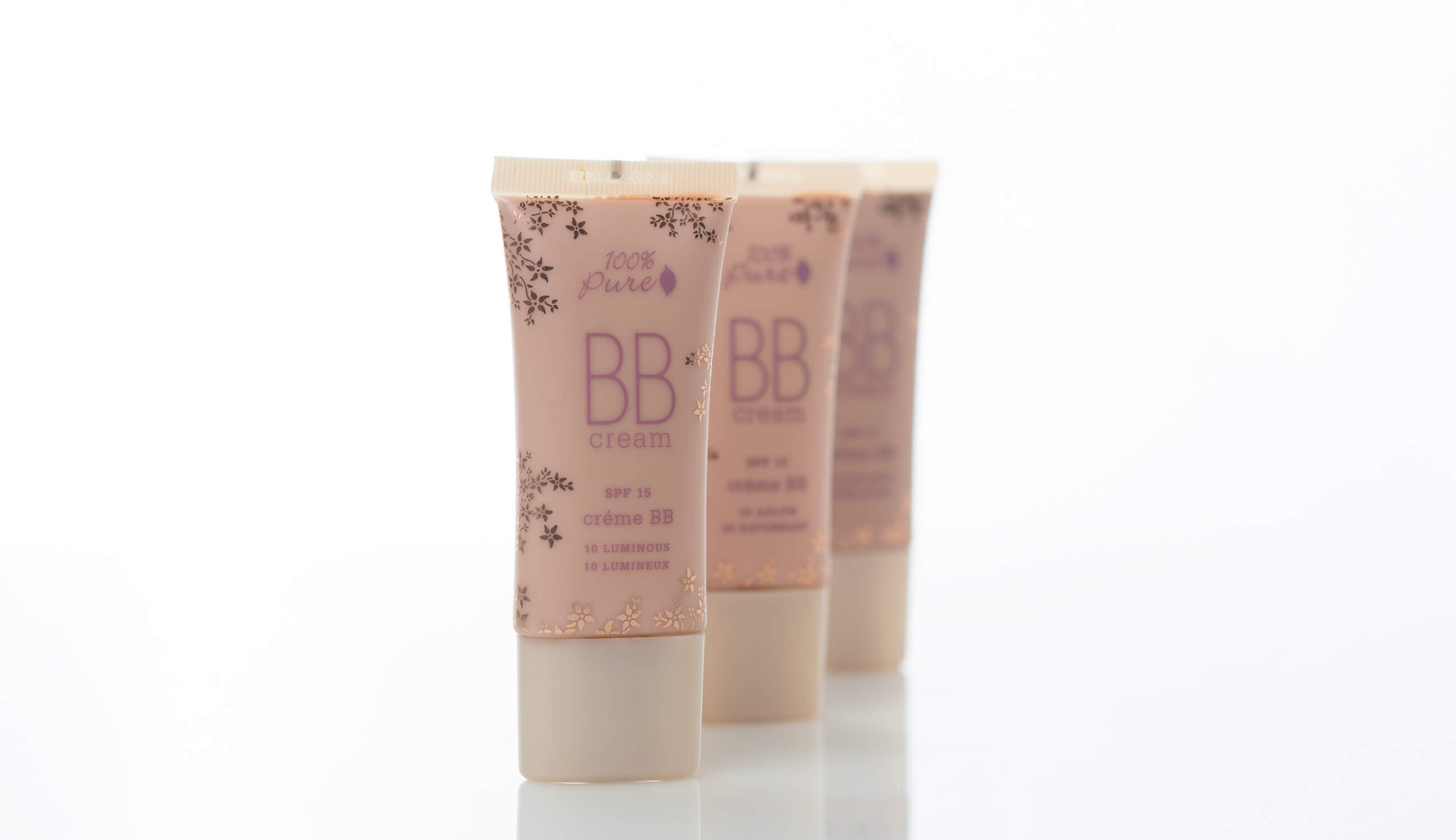What sets these two makeup heroes apart, and which one is right for you?
Updated on October 19, 2018 Written by: 100% PURE®
If you’ve ever wasted precious minutes in the makeup aisle agonizing over the differences between foundation and tinted moisturizer, we’re here to set the record straight. For all intents and purposes, there are more similarities between the two products than differences – but, as always, the devil’s in the details!
When beauty editors road test tinted moisturizers and foundations, they get down to brass tacks: how well does the product cover imperfections? How heavy does the foundation feel once applied on the skin? Does it last all day? We’re grateful to editors who take the time to suss out what makes these products different, and let us know who should be using them. We’ve compiled some of our favorite notes below!

Tinted Moisturizer
According to Shannon Romanowski at Self, a tinted moisturizer generally contains more humectants – which means it helps keep moisture locked into your skin. “Tinted moisturizers are usually best for women with dry skin and women that don’t need quite as much coverage,” explains Romanowski.
As you might be able to guess from the name, tinted moisturizer is pigmented – which means it’s perfect if you just need a light correcting base. But while it does offer color, a tinted moisturizer normally won’t give you a full coverage effect. These hydrating formulas can also include other goodies, like sunscreen or antioxidants, to help keep your skin looking young and fresh.

Foundation
Liquid foundation, on the other hand, commonly has less moisturizing power than a tinted moisturizer – but way more pigment. “A foundation covers the skin with a layer of color and gives it a flawless finish,” confirms O Magazine’s beauty director, Valerie Monroe. That’s part of what makes liquid foundation such an appealing choice for fashion editors – not only does it provide an incredible base to build up your look, but it also masks any and all imperfections. Liquid foundation is also heavier in texture, but blends more easily -- another reason why makeup artists love it.
When you’re choosing which product to add to your shopping cart, knowing the basics helps. But there are plenty of other very personal preferences you might want to consider, too. Here’s a mini-checklist to keep in mind, to answer the ultimate question: should I use tinted moisturizer, or foundation?
1. Do You Want to Cover Up, or Go Au Naturel?
Are you after that fresh, dewy face straight from the spa? Or do you need to master professional polish with a matte, no-nonsense look? Whatever style you’re dying to try, choosing between tinted moisturizer and liquid foundation can make all the difference.
Tinted moisturizers and BB creams – with lighter textures and less pigmentation – will help you nail fresh-faced appeal. “I love tinted moisturizer, because its sheer coverage evens out your complexion in the most natural-looking way," makeup artist Laura Mercier told Allure. Stuck between two tinted moisturizer shades? “It’s better to go darker than lighter, so you warm up your skin instead of looking too pale," Mercier adds. Our Fruit Pigmented Tinted Moisturizer comes in eight customized shades and offers medium coverage for a fresh, dewy face.
On the other hand, liquid foundation offers fuller (and often, more matte) coverage. It’s better for filling and smoothing fine lines, and covering dark spots, redness, and blemishes. Full coverage and a more smooth, mattified finish will make skin look a bit more polished, since a tinted moisturizer is more for a ‘no makeup’ on the skin. Our Fruit Pigmented® Healthy Foundation is a great option for full, matte coverage that won’t weigh you down. Want full coverage with a satin, lightly dewy finish that takes a page from tinted moisturizer’s book? Try our Full Coverage Water Foundation.
Blend carefully on the back of your hand with a makeup sponge before applying to your cheeks, forehead, and chin. If you want a more lightweight finish, Mercier suggests cutting your foundation with water, so dampen your makeup sponge before applying.
2. What Does the Calendar Say?
Warmer weather equals less makeup (no melting faces over here), which means reaching for a lighter base product, like tinted moisturizer. Not only will this strategy give your pores a vacation from heavy foundation, but both tinted moisturizer and BB cream often include sunscreen in their formulas (bonus!). When you’re on the go, it’s nice to have a one-and-done product in your makeup bag
If you can’t live without foundation in warmer months, try out a powder version for maximum coverage with minimal weight. Our Fruit Pigmented® Powder Foundation offers medium coverage with a near-matte finish. It’s also an effective oil and shine minimizer, making it the ultimate warm weather foundation.
3. Check In with Your Skin
When it comes to finding the right foundation, one size doesn’t fit all. Knowing whether you’re prone to breakouts or in need of major moisture will help you make the best decision for you and your pores. “If your skin is oily, use oil-free liquid or powder foundation,” advises Jessica Maitlin at O Magazine. “If you have combination skin, strategically apply a powder foundation” to your T-zone, she adds.
Aging or dry skin will benefit from a cream-based foundation. Cream formulas provide both deep moisture and enough body to fill and smooth fine lines. Our Fruit Pigmented® Cream Foundation is filled with anti-aging antioxidants, hydrating aloe, calming calendula, and moisturizing avocado butter. Made to nourish your skin while giving a creamy, natural satin finish.

4. To BB or Not to BB
When Googling ‘tinted moisturizer’, you’ll find similar products like BB cream– the Korean beauty phenomenon – in the same results pool. So what’s the difference? “Think of BB creamsas multivitamins for your face,” suggests Andrew Sotomayor at Glamour. “They usually contain sunscreen, moisturizer, color, and anti-aging ingredients.”
Looking for maximum coverage? You can use BB cream after your primer and before a light foundation – it might even help you wear less foundation overall, since BB cream can correct your color, too. In short, these “beauty balm” formulas can give you multi-tasking light coverage and a healthy, glowing complexion.
5. Textured Trio
If you tend to suffer from breakouts or are simply looking for more coverage, then foundation is definitely the way to go. But how do you begin to tell which foundation will work best for you? While some of this comes down – yet again – to personal preference, many foundations are designed with specific skin types in mind. Let’s break it down:
Liquid foundation
Even in this category, there are tons of options! Have trouble with breakouts? Look for a foundation that’s oil-free – even a heavily water-based foundation with a tiny bit of oil will do. Worried about drying out? Opt for a moisture-rich formula to keep your pores hydrated.
Powder foundation
Sensitive skin does best with a loose powder foundation, while pressed powder foundations work wonders for oily or combination skin.
Cream foundation
If your skin needs a little extra moisture, opt for a creamy foundation and apply with a makeup blender. Blend out creases with a stippling brush for even, airbrushed-looking coverage.
While skin type can go a long way in pointing you towards your perfect foundation, finding the best shade for your skin tone is perhaps even more important -- unless you want to have a ‘mask’ of foundation that ends at your jawline, or look like you’re two different shades in those tagged photos that pop up on your feed.
According to CoverGirl scientist Sarah Vickery, most women struggle with finding the right color. “Only 15 percent of women choose the correct shade if the appropriate tools aren't provided,” Vickery told Fitness. Ouch! That means many of us are stumbling around in the dark. If you can, try a little bit of the shade on your jaw in natural light before taking it home. Don’t be shy in asking for help, either – it definitely doesn’t pay to wear the wrong shade all season long.
While there’s plenty to consider as you’re finding the right fit for your makeup bag, remember there are really no wrong answers. It all comes down to what feels best on your skin – and what won’t cause you to break out or dry up. If you’re true to your skin type, the rest will come with practice – and lots of expert blending!
- Tags: Makeup, October-2018
We carefully hand-select products based on strict purity standards, and only recommend products we feel meet this criteria. 100% PURE™ may earn a small commission for products purchased through affiliate links.
The information in this article is for educational use, and not intended to substitute professional medical advice, diagnosis, or treatment and should not be used as such.











